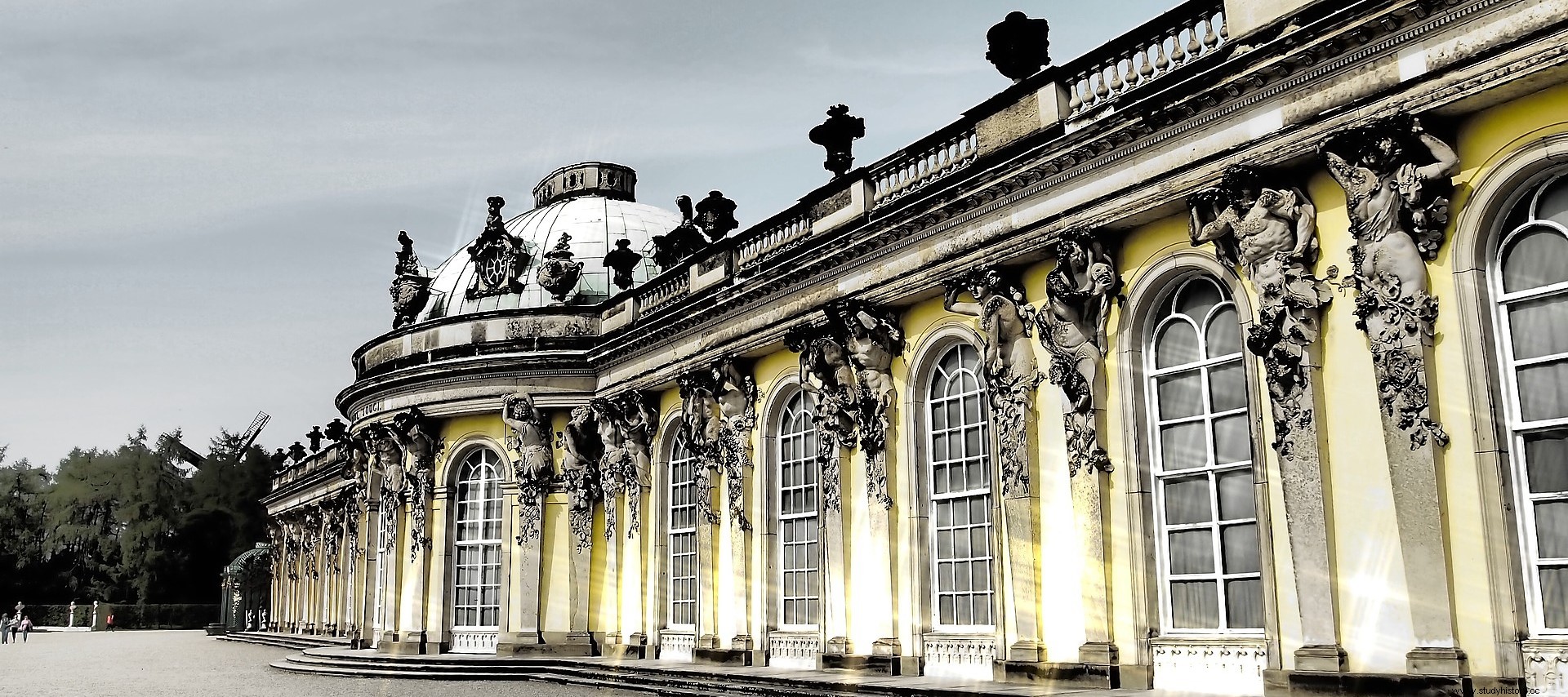
As soon as the eighteenth century began, a new kingdom emerged strong in Europe. On the territories of the old electorate of Brandenburg and united to those of the Duchy of Prussia, with capital in Berlin. Its first king will be Frederick I and his name will be Prussia, which by the way will become a real "headache" for Europe for the next two centuries.
To catch up with European rivals in that 18th century, you had to work fast. Its first king Federico I carries out the great administrative work, shortly after his successor Federico Guillermo I turns it into a military power. So for the third of them, apart from consolidating the new country, the mission was to beautify it and put it at the height of its new and ephemeral ally. This was none other than France, therefore Frederick II the Great set out to build Versailles of his own. The chosen location is outside of Potsdam.
Frederick II the Great.
To understand the curious Palace of Sanssouci a little better, we must meet its patron. Frederick II was born in Berlin in 1712, his early years and possibly the rest of his life were marked by the harsh upbringing of the Sergeant King, as his father was known. The latter never claimed that his son was in love with music, art and literature, even directly accusing him of homosexuality for it. But not only that, since he even ordered the execution of his alleged partner, the young Katte, with whom he planned to flee to England.
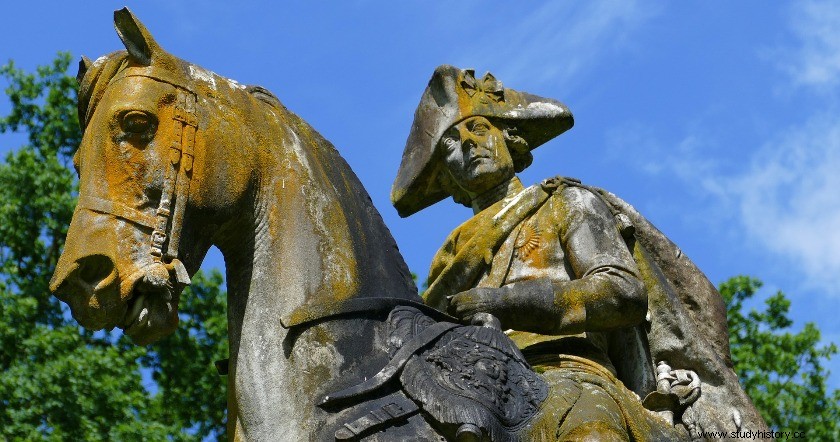
Despite his harsh childhood, he never gave up on his efforts. In the year 1740 after the death of his father he became King of Prussia. As such he became one of the most important enlightened despostas in Europe. Among his achievements stands out the codification of Prussian Law, the abolition of torture, or the protection of the national industry. All this without forgetting the policy of aggrandizement of the borders and the strengthening of the new Prussian Kingdom.
But what he highlighted most brilliantly was his innate talent for art. In music he worked from composer to flute player. He also became a great poet and even wrote about philosophy, all in the language of fashion among the French Enlightenment. Great enlightened men, poets, philosophers, mathematicians, musicians, and so on, passed through his court. But the most prominent was the writer and historian Voltaire, who spent three years with King Frederick II in the Palace of Sanssouci. Interestingly, it should be noted that women never passed through the Palace, possibly his father was right, despite his marriage to Isabel Cristina of Brunswick-Bevern, with whom he only met at family celebrations, and who of course did not give him any children. .
Sanssouci Palace.
In 1745 Frederick II had his summer palace built. The obligations of the royal position must have been very great for our character, and he decided to look for a place where he could show himself openly just as he was. The chosen place was the outskirts of Potsdam and the person in charge of the work was his friend, the brilliant architect G. W. Knobelsdorff. The works lasted three years and the chosen name Sanssouci (without worries), a declaration of interests.
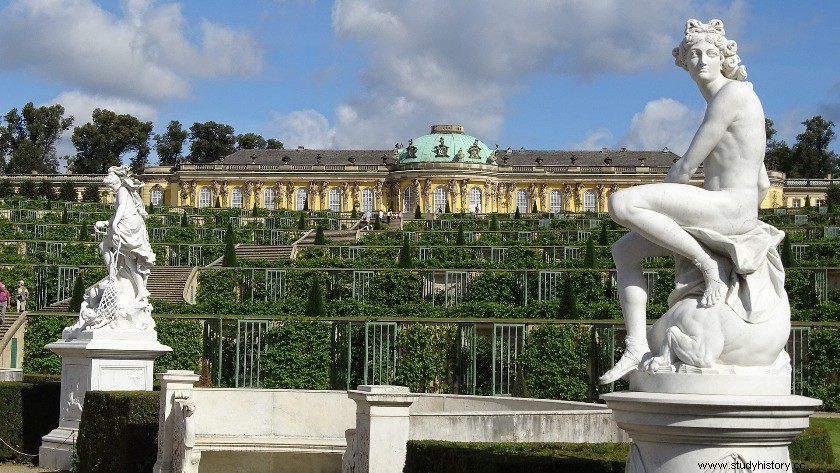
The Palace of Sanssouci above the vineyards
The Palace itself is not very big, it is on one level and with three wings, if from the outside it is not really very spectacular, with few decorations of angels and vases. Inside in a demonstration of the purest rococo style. By the way, the one in this palace has been given the nickname "federician" in honor of King Frederick II.
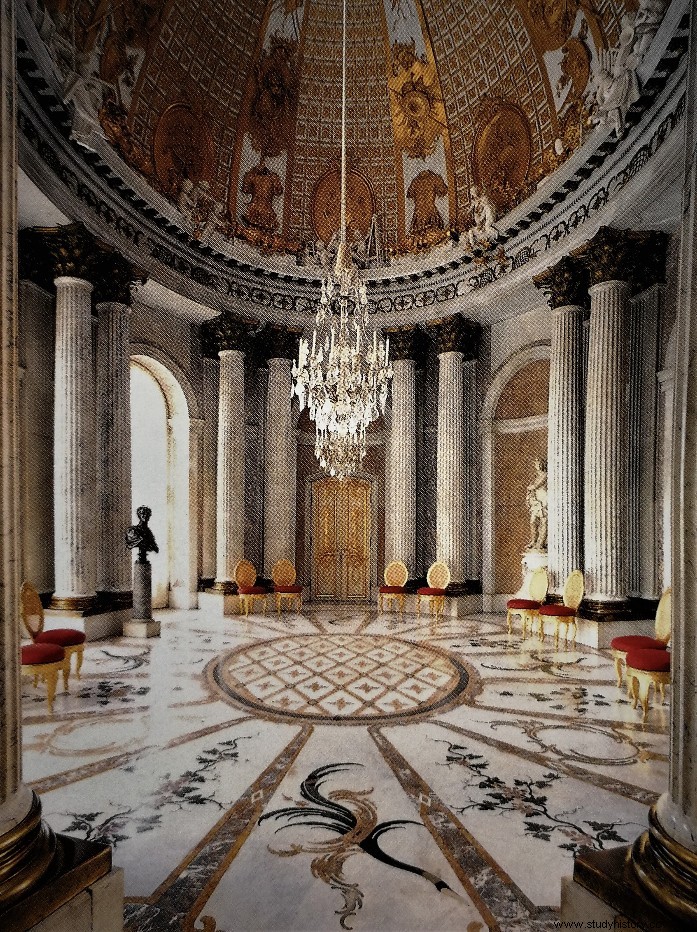
The marble room
As soon as we enter we find the hall room and just behind it the Marble Room, where Federico II received his guests. Both adorned with Corinthian-style columns, and gold motifs everywhere. The rest of the Palace are specific rooms, a concert hall, a library, the king's room and the guest room, such as Voltaire's room, which still bears his name.
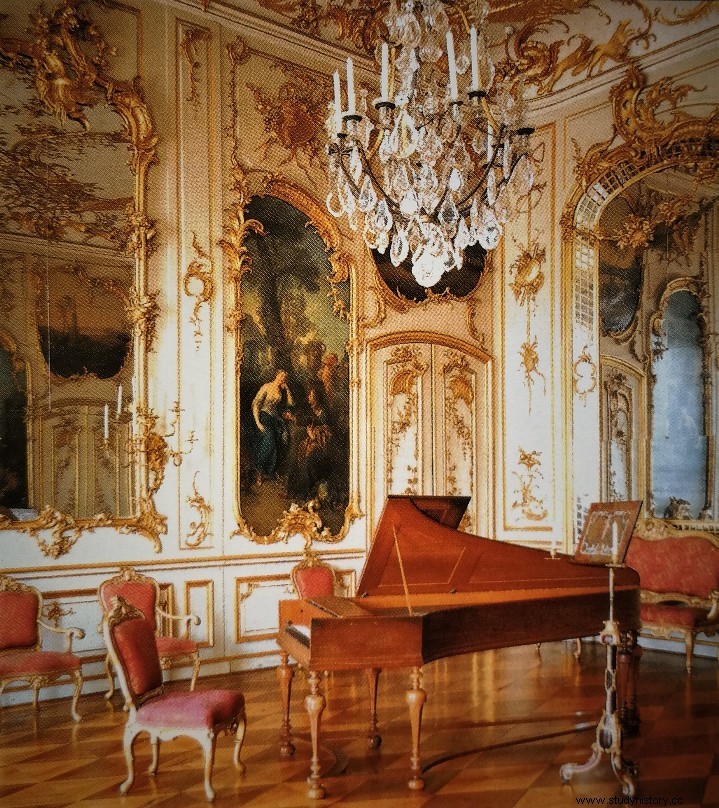
The concert hall.
The Palace was completed in later years with two more small wings, one of which housed the service, and the other was used for the private collections of King Frederick II. The latter died in the same Palace of Sanssouci in 1786 and there he is buried without great pretensions. This point is noteworthy, since all the luxury of the palace was never transferred to the pantheon of the deceased king, in short, he was a declared atheist and did not need certain recognition.
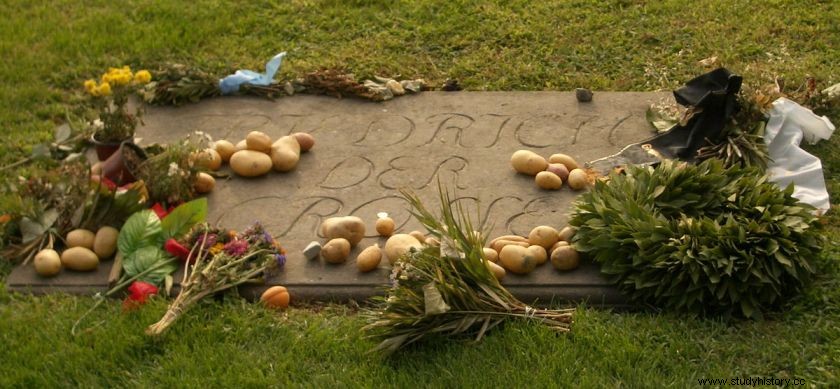
The Germans continue to bring potatoes to Frederick II, to thank him for being one of the introducers of the tuber in Prussia.
Sanssouci Park.
If the Palace is spectacular, the rest of the facilities are not far behind. The entrance to the palace is through a semicircular arcaded square, depending on how we visit the place, it may seem like the back, but it is not. From this rear part there is a staircase that descends to the Sanssouci Park through six terraces of vineyards. On both sides of the palace there are two places that are a must, in one of them a rococo gazebo adorned with a golden sun. Meanwhile, in the other we find the aforementioned tomb of Federico II.
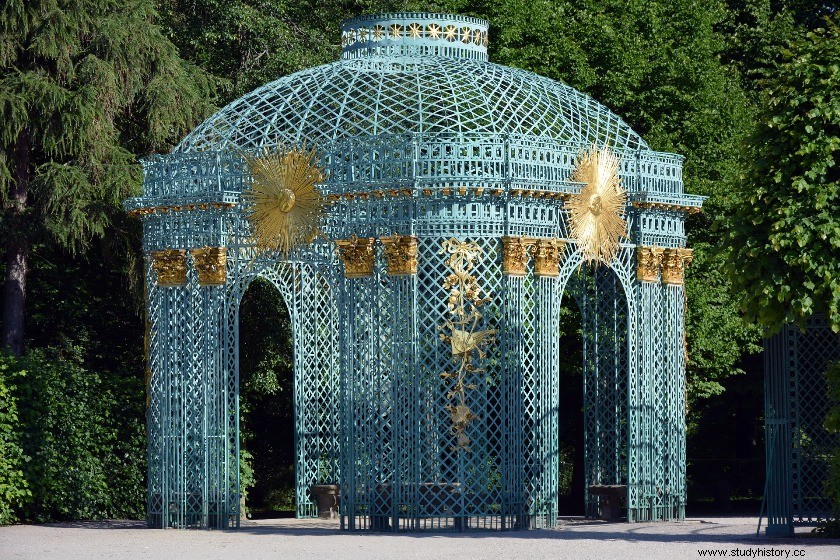
Federico II's gazebo, some say it was a kind of temple to the sun.
The rest of the Sanssouci Park apart from the large forests surrounded by hedges and with multiple flowers, which really recommend a visit in summer. It is full of other unique buildings.
To see the first of them we must leave the park through one of the side entrances, which is clearly visible by the way. I am referring to a mill that can be seen from all sides at the back of the Sanssouci Palace. This mill was ordered to be built by Frederick II the Great in the last days of his life. The motif commemorates the traditional way of life of the inhabitants of Potsdam on the hill, before the arrival of the Prussian kings. At least 20 of them are documented, who disappeared before said arrival. The current one is still in service for visitors to demonstrate, and you can also see an exhibition on life in this type of building.
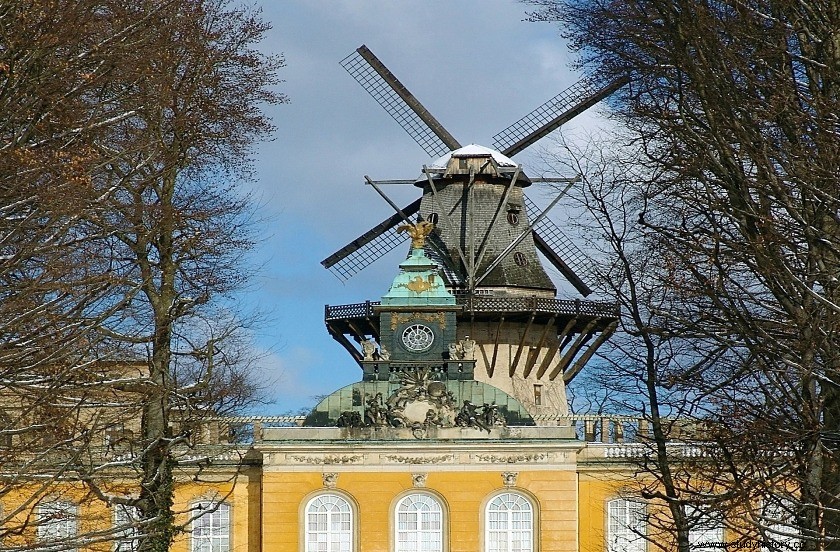
The mill behind the Sanssouci palace
Other unique buildings in the Park.
Among the gardens of the Sanssouci Park we find two unique buildings made in the rococo style, but with a great Oriental influence. Both ordered to be built by Frederick II in the years after the construction of the Sanssouci Palace. First of all, the Chinese Palace, which was actually a place to go with high-ranking leaders to drink tea. Secondly, an even smaller building called the House of the Dragon, its functionality in the time of Frederick the Great an unknown.
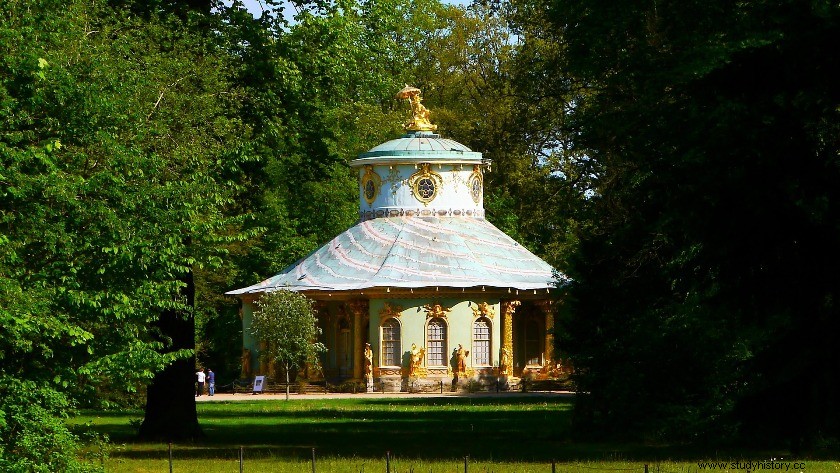
The Tea Room
The Palace of the Orangerie, ordered to be built by one of Frederick II's successors from 1850. Specifically King Frederick William IV, the palace was actually a huge nave about a hundred meters long and with huge windows. Their first service was to store fruit trees for the long winters in the city of Potsdam.

The Orengerie Palace
We leave the great project of Federico II for last. At the end of the Seven Years War and to commemorate his victory, he decides to build the New Palace. In this case the largest of all the palaces in Potsdam, more than 200 meters long, its view from the main avenue is impressive. Inside we find multiple rooms, among them two are the ones that attract the most attention. The first of them is the Grotto room finished off with decorations of shells and corals. In addition, we can see statues of Charlemagne, Caesar and Constantine, a fact that relieves us of the dream of the emperor that haunts our character. The other of the rooms more in keeping with Federico II the Great, since it is a small and charming theater.
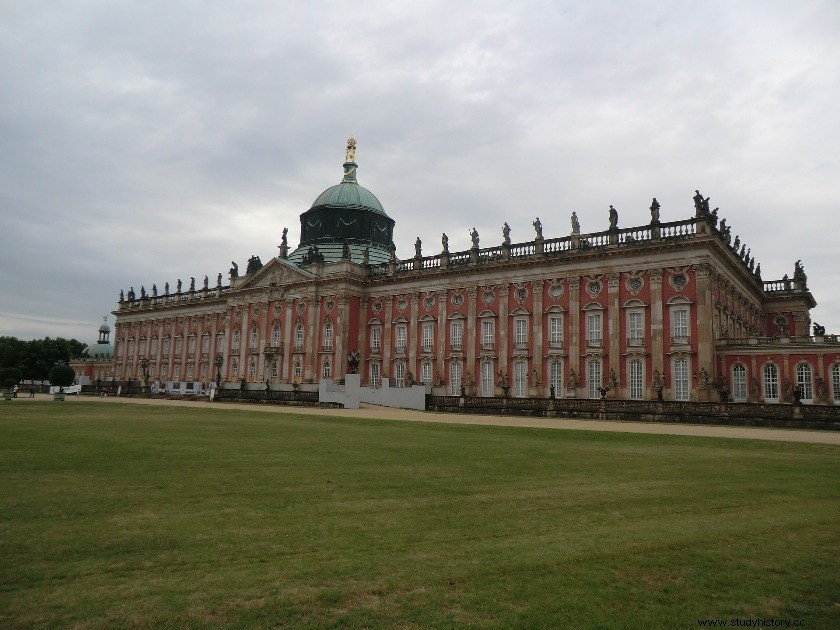
The New Palace in Potsdam
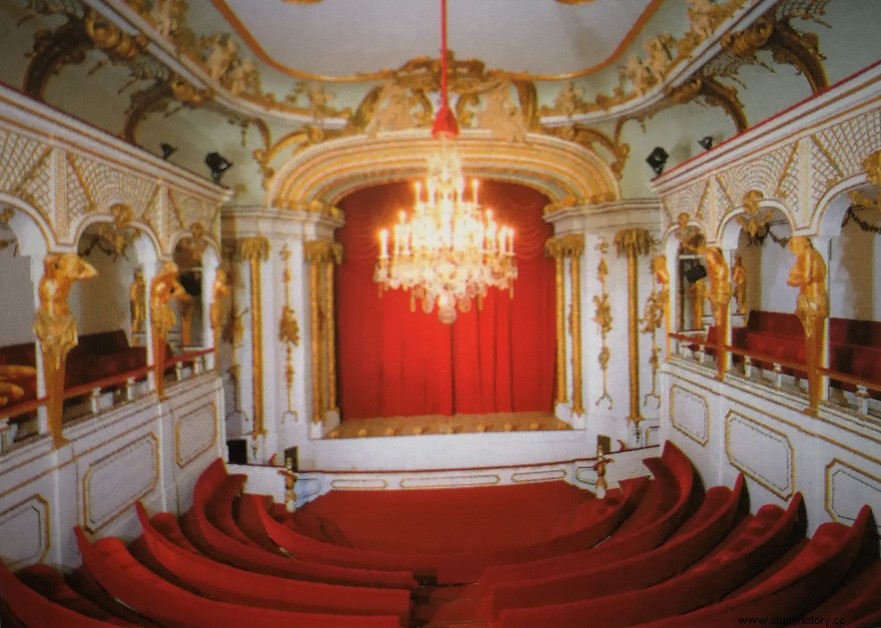
the small theater of the Palace.
Finally, we recommend visiting in summer, the walk through the gardens is free but the entrance to the palaces is not excessively cheap. Its price depends on several factors, which I encourage you to learn about on this page:spsg
Images:pixabay
